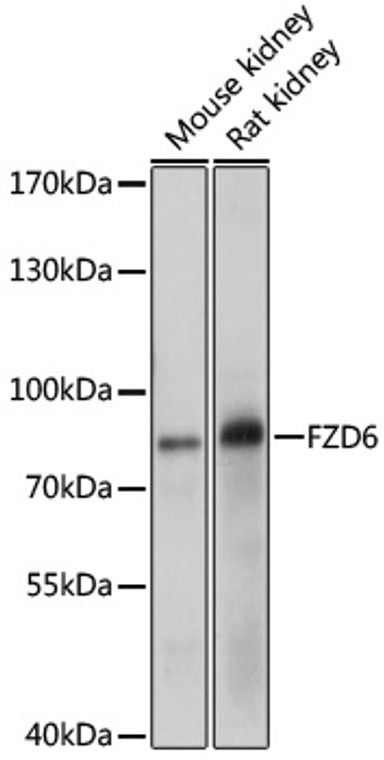| Host: |
Rabbit |
| Applications: |
WB/ELISA |
| Reactivity: |
Mouse/Rat |
| Note: |
STRICTLY FOR FURTHER SCIENTIFIC RESEARCH USE ONLY (RUO). MUST NOT TO BE USED IN DIAGNOSTIC OR THERAPEUTIC APPLICATIONS. |
| Clonality: |
Polyclonal |
| Conjugation: |
Unconjugated |
| Isotype: |
IgG |
| Formulation: |
PBS with 0.02% Sodium Azide, 50% Glycerol, pH 7.3. |
| Purification: |
Affinity purification |
| Concentration: |
Lot specific |
| Dilution Range: |
WB:1:1000-1:2000ELISA:Recommended starting concentration is 1 Mu g/mL. Please optimize the concentration based on your specific assay requirements. |
| Storage Instruction: |
Store at-20°C for up to 1 year from the date of receipt, and avoid repeat freeze-thaw cycles. |
| Gene Symbol: |
FZD6 |
| Gene ID: |
8323 |
| Uniprot ID: |
FZD6_HUMAN |
| Immunogen Region: |
19-201 |
| Specificity: |
Recombinant fusion protein containing a sequence corresponding to amino acids 19-201 of human FZD6 (NP_003497.2). |
| Immunogen Sequence: |
HSLFTCEPITVPRCMKMAYN MTFFPNLMGHYDQSIAAVEM EHFLPLANLECSPNIETFLC KAFVPTCIEQIHVVPPCRKL CEKVYSDCKKLIDTFGIRWP EELECDRLQYCDETVPVTFD PHTEFLGPQKKTEQVQRDIG FWCPRHLKTSGGQGYKFLGI DQCAPPCPNMYFKSDELEFA KSF |
| Tissue Specificity | Detected in adult heart, brain, placenta, lung, liver, skeletal muscle, kidney, pancreas, thymus, prostate, testis, ovary, small intestine and colon. In the fetus, expressed in brain, lung, liver and kidney. |
| Post Translational Modifications | Ubiquitinated by ZNRF3, leading to its degradation by the proteasome. |
| Function | Receptor for Wnt proteins. Most of frizzled receptors are coupled to the beta-catenin canonical signaling pathway, which leads to the activation of disheveled proteins, inhibition of GSK-3 kinase, nuclear accumulation of beta-catenin and activation of Wnt target genes. A second signaling pathway involving PKC and calcium fluxes has been seen for some family members, but it is not yet clear if it represents a distinct pathway or if it can be integrated in the canonical pathway, as PKC seems to be required for Wnt-mediated inactivation of GSK-3 kinase. Both pathways seem to involve interactions with G-proteins. May be involved in transduction and intercellular transmission of polarity information during tissue morphogenesis and/or in differentiated tissues. Together with FZD3, is involved in the neural tube closure and plays a role in the regulation of the establishment of planar cell polarity (PCP), particularly in the orientation of asymmetric bundles of stereocilia on the apical faces of a subset of auditory and vestibular sensory cells located in the inner ear. |
| Protein Name | Frizzled-6Fz-6Hfz6 |
| Database Links | Reactome: R-HSA-373080Reactome: R-HSA-4086398Reactome: R-HSA-4086400Reactome: R-HSA-4641263Reactome: R-HSA-5340588 |
| Cellular Localisation | MembraneMulti-Pass Membrane ProteinCell MembraneCell SurfaceApical Cell MembraneCytoplasmic Vesicle MembraneEndoplasmic Reticulum MembraneColocalizes With Fzd3 At The Apical Face Of CellsLocalizes To The Endoplasmic Reticulum Membrane In The Presence Of Lmbr1l |
| Alternative Antibody Names | Anti-Frizzled-6 antibodyAnti-Fz-6 antibodyAnti-Hfz6 antibodyAnti-FZD6 antibody |
Information sourced from Uniprot.org
12 months for antibodies. 6 months for ELISA Kits. Please see website T&Cs for further guidance







